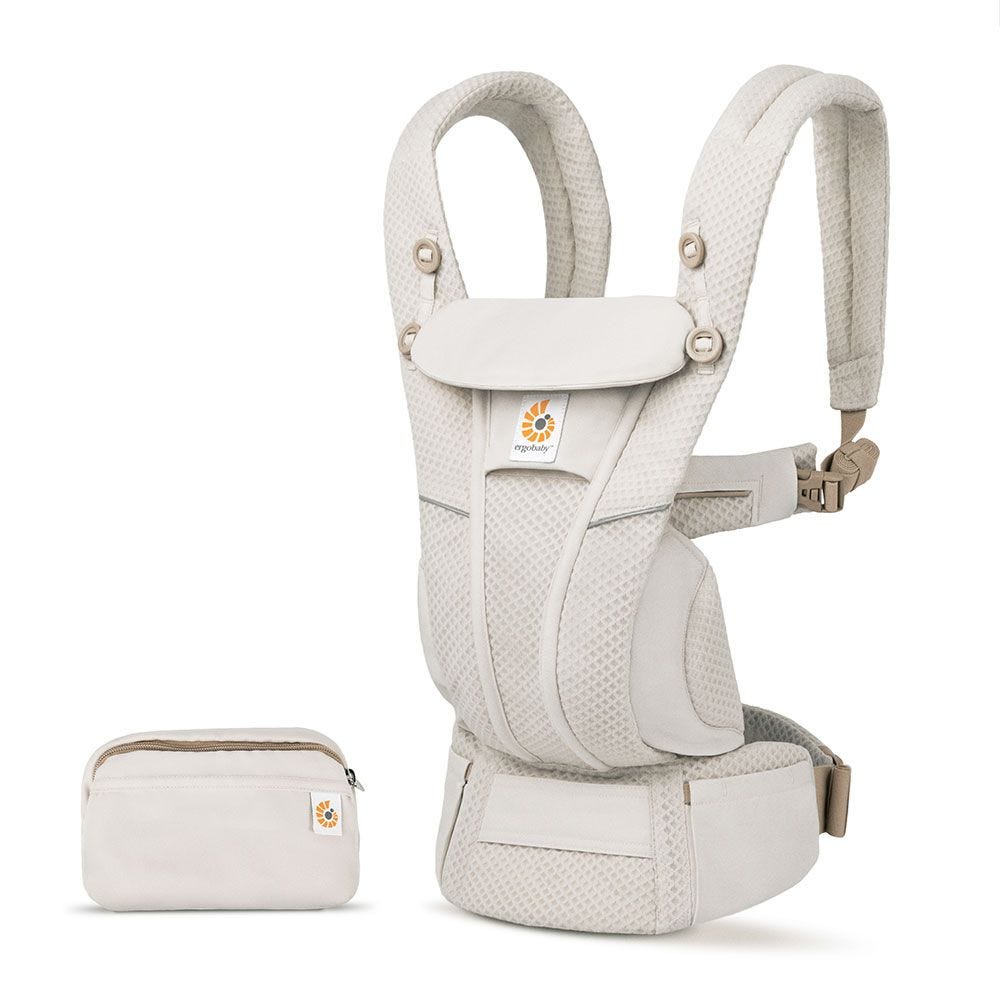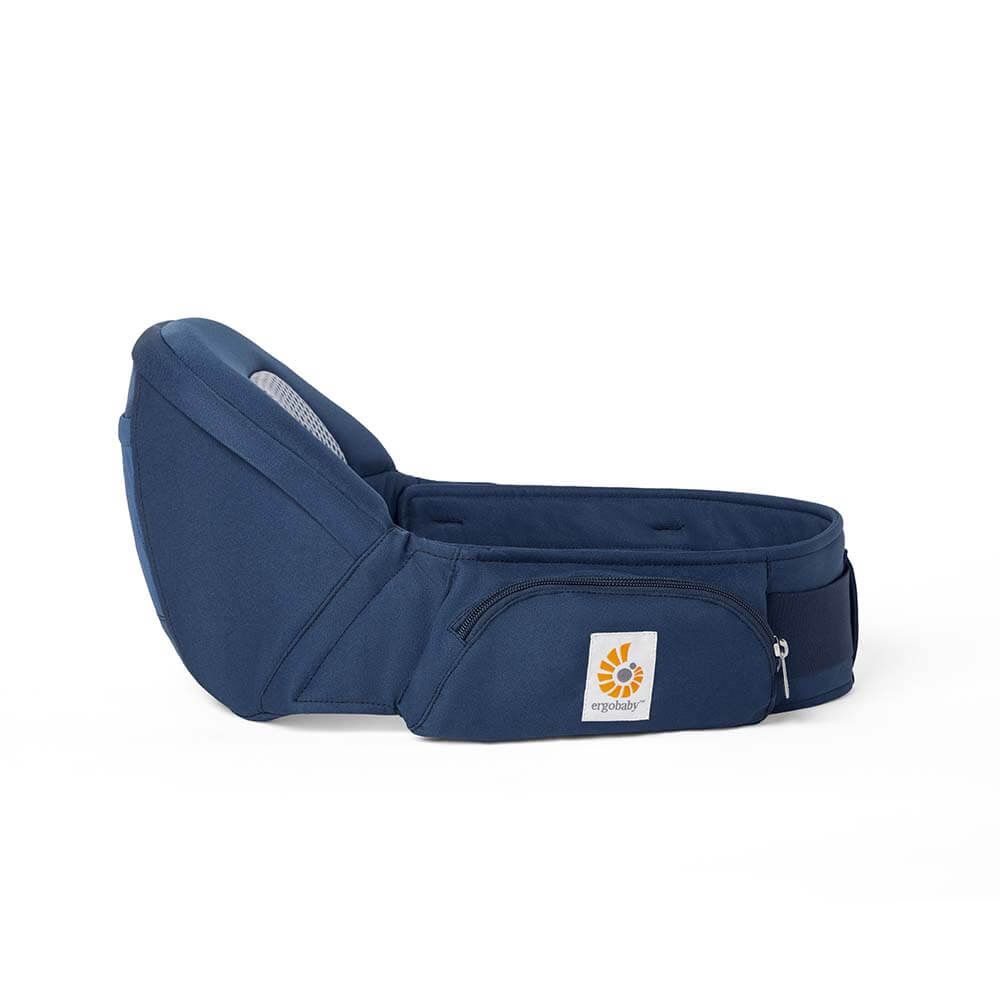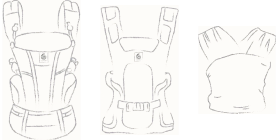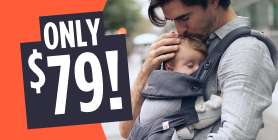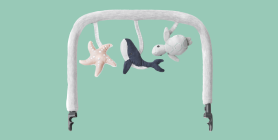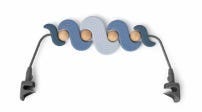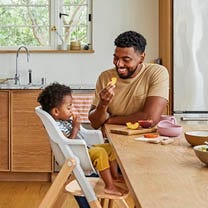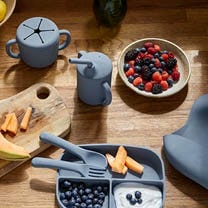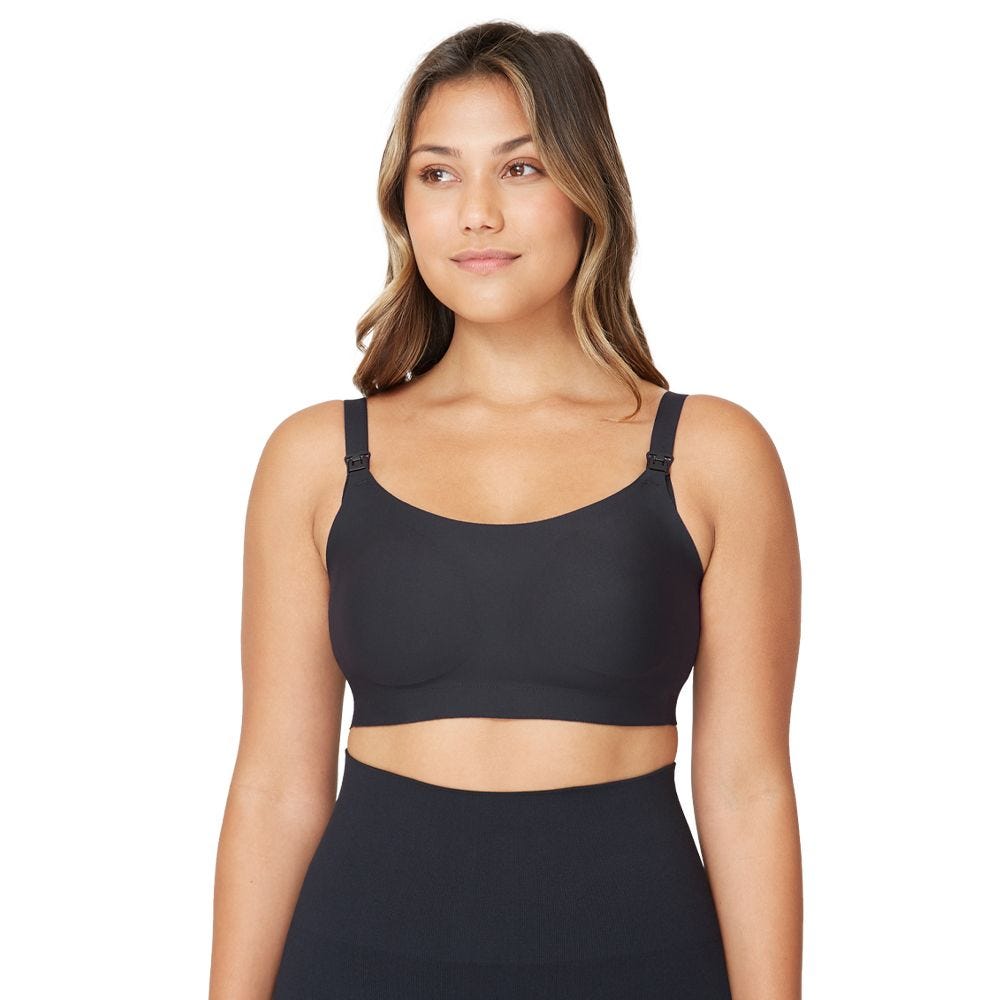


Embrace Newborn Carrier
Merges the coziness of a soft wrap with the simplicity of a carrier. Available in soft knit or breathable mesh.
- Soft and cozy, made especially for the comfort of newborns
- Simple and easy to use. No complicated wrapping or tying involved!
- Hip Healthy Positioning by The International Hip Dysplasia Institute (IHDI)
- Facing In and Facing Out Carry Positions
- Ergopromise Lifetime Guarantee

At A Glance
 Newborn ready
Newborn ready
 Simple to Use
Simple to Use
 Soft & Cozy
Soft & Cozy
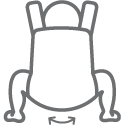 Ergonomic & Hip Healthy (M-position)
Ergonomic & Hip Healthy (M-position)
 Cross Straps and Padded Waistbelt
Cross Straps and Padded Waistbelt
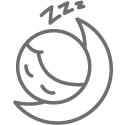 Cushioned Neck Support
Cushioned Neck Support
 Breastfeeding Friendly
Breastfeeding Friendly
Product Description
Product Features

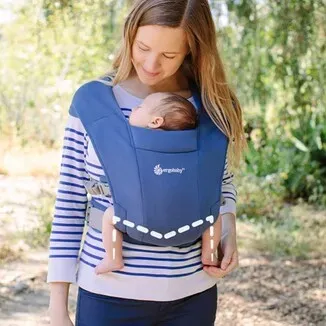

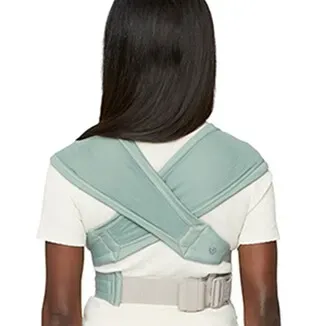
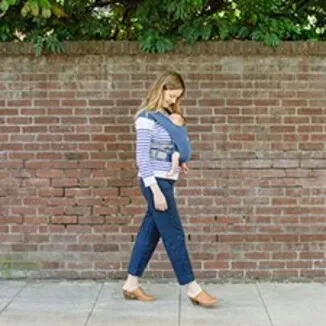
Carry Modes



Comparison
Fit


Pant Size: 4
S


Pant Size: 16
XL


Pant Size: 42
XXL
Instructions
Ages & Stages
Faqs
What is the age / weight / height range for the Embrace carrier?
Can I use the Embrace baby carrier with my newborn baby?
Yes, the Embrace baby carrier was designed for the newborn phase. Babies must meet the minimum 20 inches/50.8 cm height and 7 lbs./3.2 kg weight.
The Embrace baby carrier adjusts to your newborn baby when the waistbelt is folded in twice in the Newborn Mode – Facing In position by shortening the back panel and narrowing the seat width.
What is the maximum weight for baby to be carried in the Embrace baby carrier?
Can I breastfeed with the Embrace baby carrier? How does that work?
How many ways can I carry my baby?
The Embrace baby carrier has three modes you can use to carry baby:
- Newborn Mode - Facing In
- Baby Mode - Facing In
- Baby Mode - Facing Out
Your baby's height and developmental milestones will determine the best mode to use.
- Newborn Mode - Facing In: From birth (at least 7 lbs./3.2 kg and 20 in/50.8 cm) to 23 in/58.4 cm (around 2 months). The Embrace baby carrier adjusts to your newborn baby when the waistbelt is folded in twice in the Newborn Mode – Facing In position by shortening the back panel and narrowing the seat width.
- Baby Mode - Facing In: From 23 in/58.4 cm (around 2 months) and up to 25 lbs./11.3 kg
- Baby Mode - Facing Out: An additional option for babies with strong head and neck control and taller than 26 in/66 cm (around 5-6 months). Baby’s face and chin must always clear the top of the panel.
Please refer to the instruction manual and instruction videos for each carry mode before using your Embrace carrier and before attempting new modes or positions.
Do I need to use the Ergobaby Infant Insert with the Embrace?
When is baby ready to be carried in Baby Mode - Facing In carry position?
Baby is ready to be carried in the Baby Mode (facing in) when they are taller than 23 in/58.4 cm - typically around 2 months. Because the waistbelt is secured with the panel hanging down like an apron, the Baby Mode - Facing In position allows for a longer back panel and wider supported seat for baby.
Babies shorter than 23 in/58.4 cm should be carried in the Newborn Mode – Facing In position, where the waistbelt is flipped inward twice to make the back panel shorter and seat width narrower.
When is baby ready to be worn in the Baby Mode - Facing Out carry position?
As a parent, how do I decide which mode is better for my child: newborn mode, baby facing in mode, or baby facing out mode? And how can I know?
Knowing which mode to carry baby in will depend on baby’s height and the developmental milestones they’ve hit. Newborns under 23 in./58.4 cm should be carried in the Newborn Mode – Facing In with the waistbelt flipped inwards twice.
However, once they reach 23 in/58.4 cm, you can begin carrying in the ‘Baby Mode - Facing In’ and you no longer need to flip the waistbelt.
As your baby grows older and can see above the front panel of the carrier, has strong head & neck control, and has a natural curiosity to see and interact with the world, they are ready for front-outward carry. We recommend starting with short durations (5-10 minutes) to prevent over-stimulation.
Here are some signs that baby is becoming over-stimulated and ready to switch back to baby facing in mode:
- Baby seems tired, cranky, or fussy
- Baby is rubbing its eyes
- Baby is spreading fingers and toes, making fists
- Baby is laying hands in front of face
- Baby is ‘spacing out,’ sometimes baby will turn away and simply space out
- Baby is turning away again and again, trying to ‘switch off’
- If this all becomes too much for baby, baby may become drowsy
- Baby becomes hyper-vigilant (overly attentive). Instead of relaxed, baby’s body may stiffen
If you notice these cues, we recommend switching baby to inward facing carry position and/or create a quiet, calm environment to help baby relax and recharge.
Can I carry my newborn baby in the facing out position?
No. You should never carry your baby facing out until the following developmental milestones are met:
- Once they are over 26 in/66 cm
- Display good head and neck control
- Chin clears the back panel when in good positioning
How do I know if my baby is ready for baby facing out mode?
Babies are born with an immature nervous system and are easily overstimulated by too much noise, activity, and sensation in the world around them. Baby simply can't process it all and needs some quiet time, a moment to relax, and a chance to calm down.
Once your baby can see above the front panel of the carrier, has strong head & neck control, and has a natural curiosity to see and interact with the world, they are ready for front-outward carry. We recommend starting with short durations (5-10 minutes) to prevent over-stimulation.
Here are some signs that baby is becoming over-stimulated and ready to switch back to baby facing in mode:
- Baby seems tired, cranky, or fussy
- Baby is rubbing its eyes
- Baby is spreading fingers and toes, making fists
- Baby is laying hands in front of face
- Baby is ‘spacing out,’ sometimes baby will turn away and simply space out
- Baby is turning away again and again, trying to ‘switch off’
- If this all becomes too much for baby, baby may become drowsy
- Baby becomes hyper-vigilant (overly attentive). Instead of relaxed, baby’s body may stiffen
If you notice these cues, we recommend switching baby to inward facing carry position and/or create a quiet, calm environment to help baby relax and recharge.
Is forward facing comfortable for parents?
How do I wear the Embrace carrier waistbelt?
How should the shoulder straps be worn? How do I wear the shoulder straps?
How do I make sure my baby’s head is supported with the Embrace baby carrier?
How do I make sure my baby’s hips are in an ergonomic spread-squat position (M-position) with thighs well supported and baby's back supported in a natural position in the Embrace carrier?
How does the Embrace differ from a wrap like the Aura wrap?
How does the Embrace differ from the other Ergobaby soft structured carriers like the Adapt and Omni 360?
Are there any certifications acknowledging the Ergobaby Embrace carrier is ergonomic?
Does the Embrace Knit carrier have any harmful materials?
What kind of fabric is the Embrace baby carrier made of and how does it differ from the other Ergobaby soft structured carriers?
Is the Embrace baby carrier machine washable?
What is the weight of the Embrace carrier?
Embrace Knit weighs in at 17 ounces/480 grams.
Embrace Soft Air Mesh weighs in at 15 ounces / 420 grams.
What sizes does the Embrace baby carrier fit?
How much smaller is the Embrace carrier panel when folded twice in the Newborn Mode - Facing In vs. the Baby Modes?
What are the measurements of the shoulder straps and waistbelt?
The padded part of the waistbelt is 2.8 in/7 cm wide and 22.4 in/57 cm long. The waistbelt webbing is 32.3 in/82 cm long.
The spreadable shoulder straps are 3.9 in/10 cm wide. When spread out, the shoulder straps measure 9.2 in/23.5 cm. The shoulder strap webbing is 21.2 in/54 cm long.
Does the Ergobaby Embrace baby carrier come with the ErgoPromise Guarantee?
Yes, as with all our baby carriers and wraps, the Embrace comes with the ErgoPromise Lifetime Guarantee. If you find a manufacturing or material defect, we’ll replace your carrier or part at no charge.
We stand by our products so you can carry your precious cargo with confidence.
How does the Embrace Soft Air Mesh differ from the Embrace Knit?
What is the age / weight / height range for the Embrace carrier?
Can I use the Embrace baby carrier with my newborn baby?
Yes, the Embrace baby carrier was designed for the newborn phase. Babies must meet the minimum 20 inches/50.8 cm height and 7 lbs./3.2 kg weight.
The Embrace baby carrier adjusts to your newborn baby when the waistbelt is folded in twice in the Newborn Mode – Facing In position by shortening the back panel and narrowing the seat width.
What is the maximum weight for baby to be carried in the Embrace baby carrier?
Can I breastfeed with the Embrace baby carrier? How does that work?
How many ways can I carry my baby?
The Embrace baby carrier has three modes you can use to carry baby:
- Newborn Mode - Facing In
- Baby Mode - Facing In
- Baby Mode - Facing Out
Your baby's height and developmental milestones will determine the best mode to use.
- Newborn Mode - Facing In: From birth (at least 7 lbs./3.2 kg and 20 in/50.8 cm) to 23 in/58.4 cm (around 2 months). The Embrace baby carrier adjusts to your newborn baby when the waistbelt is folded in twice in the Newborn Mode – Facing In position by shortening the back panel and narrowing the seat width.
- Baby Mode - Facing In: From 23 in/58.4 cm (around 2 months) and up to 25 lbs./11.3 kg
- Baby Mode - Facing Out: An additional option for babies with strong head and neck control and taller than 26 in/66 cm (around 5-6 months). Baby’s face and chin must always clear the top of the panel.
Please refer to the instruction manual and instruction videos for each carry mode before using your Embrace carrier and before attempting new modes or positions.
Do I need to use the Ergobaby Infant Insert with the Embrace?
When is baby ready to be carried in Baby Mode - Facing In carry position?
Baby is ready to be carried in the Baby Mode (facing in) when they are taller than 23 in/58.4 cm - typically around 2 months. Because the waistbelt is secured with the panel hanging down like an apron, the Baby Mode - Facing In position allows for a longer back panel and wider supported seat for baby.
Babies shorter than 23 in/58.4 cm should be carried in the Newborn Mode – Facing In position, where the waistbelt is flipped inward twice to make the back panel shorter and seat width narrower.
When is baby ready to be worn in the Baby Mode - Facing Out carry position?
As a parent, how do I decide which mode is better for my child: newborn mode, baby facing in mode, or baby facing out mode? And how can I know?
Knowing which mode to carry baby in will depend on baby’s height and the developmental milestones they’ve hit. Newborns under 23 in./58.4 cm should be carried in the Newborn Mode – Facing In with the waistbelt flipped inwards twice.
However, once they reach 23 in/58.4 cm, you can begin carrying in the ‘Baby Mode - Facing In’ and you no longer need to flip the waistbelt.
As your baby grows older and can see above the front panel of the carrier, has strong head & neck control, and has a natural curiosity to see and interact with the world, they are ready for front-outward carry. We recommend starting with short durations (5-10 minutes) to prevent over-stimulation.
Here are some signs that baby is becoming over-stimulated and ready to switch back to baby facing in mode:
- Baby seems tired, cranky, or fussy
- Baby is rubbing its eyes
- Baby is spreading fingers and toes, making fists
- Baby is laying hands in front of face
- Baby is ‘spacing out,’ sometimes baby will turn away and simply space out
- Baby is turning away again and again, trying to ‘switch off’
- If this all becomes too much for baby, baby may become drowsy
- Baby becomes hyper-vigilant (overly attentive). Instead of relaxed, baby’s body may stiffen
If you notice these cues, we recommend switching baby to inward facing carry position and/or create a quiet, calm environment to help baby relax and recharge.
Can I carry my newborn baby in the facing out position?
No. You should never carry your baby facing out until the following developmental milestones are met:
- Once they are over 26 in/66 cm
- Display good head and neck control
- Chin clears the back panel when in good positioning
How do I know if my baby is ready for baby facing out mode?
Babies are born with an immature nervous system and are easily overstimulated by too much noise, activity, and sensation in the world around them. Baby simply can't process it all and needs some quiet time, a moment to relax, and a chance to calm down.
Once your baby can see above the front panel of the carrier, has strong head & neck control, and has a natural curiosity to see and interact with the world, they are ready for front-outward carry. We recommend starting with short durations (5-10 minutes) to prevent over-stimulation.
Here are some signs that baby is becoming over-stimulated and ready to switch back to baby facing in mode:
- Baby seems tired, cranky, or fussy
- Baby is rubbing its eyes
- Baby is spreading fingers and toes, making fists
- Baby is laying hands in front of face
- Baby is ‘spacing out,’ sometimes baby will turn away and simply space out
- Baby is turning away again and again, trying to ‘switch off’
- If this all becomes too much for baby, baby may become drowsy
- Baby becomes hyper-vigilant (overly attentive). Instead of relaxed, baby’s body may stiffen
If you notice these cues, we recommend switching baby to inward facing carry position and/or create a quiet, calm environment to help baby relax and recharge.
Is forward facing comfortable for parents?
How do I wear the Embrace carrier waistbelt?
How should the shoulder straps be worn? How do I wear the shoulder straps?
How do I make sure my baby’s head is supported with the Embrace baby carrier?
How do I make sure my baby’s hips are in an ergonomic spread-squat position (M-position) with thighs well supported and baby's back supported in a natural position in the Embrace carrier?
How does the Embrace differ from a wrap like the Aura wrap?
How does the Embrace differ from the other Ergobaby soft structured carriers like the Adapt and Omni 360?
Are there any certifications acknowledging the Ergobaby Embrace carrier is ergonomic?
Does the Embrace Knit carrier have any harmful materials?
What kind of fabric is the Embrace baby carrier made of and how does it differ from the other Ergobaby soft structured carriers?
Is the Embrace baby carrier machine washable?
What is the weight of the Embrace carrier?
Embrace Knit weighs in at 17 ounces/480 grams.
Embrace Soft Air Mesh weighs in at 15 ounces / 420 grams.
What sizes does the Embrace baby carrier fit?
How much smaller is the Embrace carrier panel when folded twice in the Newborn Mode - Facing In vs. the Baby Modes?
What are the measurements of the shoulder straps and waistbelt?
The padded part of the waistbelt is 2.8 in/7 cm wide and 22.4 in/57 cm long. The waistbelt webbing is 32.3 in/82 cm long.
The spreadable shoulder straps are 3.9 in/10 cm wide. When spread out, the shoulder straps measure 9.2 in/23.5 cm. The shoulder strap webbing is 21.2 in/54 cm long.
Does the Ergobaby Embrace baby carrier come with the ErgoPromise Guarantee?
Yes, as with all our baby carriers and wraps, the Embrace comes with the ErgoPromise Lifetime Guarantee. If you find a manufacturing or material defect, we’ll replace your carrier or part at no charge.
We stand by our products so you can carry your precious cargo with confidence.

